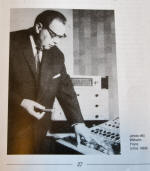-edible zone-
Review by Steve Clarke (site owner)

Notes:
publish date: 2001
Hardbound with heavy glossy
pages.
Dimensions: 7 x 9-3/4 x 9/16 inches (what....you want
metric...;-)
Text in three languages; Italian, English and German
Author main text: Stefano Pasini.
Technical advice and author of the
technical section: H.M. Fabritius
Translate to German text by H.M.
Fabritius
Elektromesstechnik (EMT)
This is a history of
the broadcast turntable production at EMT from the post war Europe
period to the late 1980's when their turntable production stopped. It
also describes the man that was the founder and guiding spirit of the
company, Wilhelm Franz.
 hint: click on thumbnail to view image full size.
hint: click on thumbnail to view image full size.
Above image:
Wilhelm Franz circa 1968
Some might have hoped for in a book a
thorough technical analysis for engineers of each EMT model -- plentiful
with exploded drawings and performance specs. It isn't that. What it is
- is a history book. Within it there are 49 images, of which most are
photos of the subject turntables, arms and cartridges. There is one
section-view drawing of an EMT 938 motor unit. Then the different
Corporate Logos used over the production history are shown. See page 9
for a view of 8 different company and product logos. But it's the story
that counts. The book offers its text in three languages; English,
Italian and German.
This is a history book -- the history of EMT
broadcast turntable production and development. Right after the intro
our narrator takes us back to the conditions on the ground in post war
Germany. Then he recounts advances in the technology of the day, just
before the war - and after the war. Described is the socio-economic
conditions in the post war period that led to the Lp record becoming a
format that would dominate music media over the next four decades. Also
discussed are the other record formats in existence at the time,
including 16 inch* records and even the 20 inch records used in the film
industry - the 12 inch 78's of the day and then the 7-inch 45. Magnetic
tape is presented as a new but not dominant media format. In this way it
describes the conditions that led to the development of what became the
EMT 927, followed by the EMT 930 broadcast turntables.
The book
reports the development and introduction of each significant EMT
turntable model in a timeline history. Documented are many variations
for each model. Reported are the first models developed in cooperation
with The Rundfunktechnisches Institut (Broadcast Institute), the R35,
followed by the R80 and finally the first turntable to wear the EMT
name; The EMT 927. Discussed briefly is a path of evolution between the
R80 and EMT 927.
Documented are the tone arms used on EMT
broadcast turntables including the Ortofon arms RF297, the RMA 297, the
RMA 229 -- and then, finally, the EMT 929 and 997 tone arms. Not to be
over-looked is the reporting of the many different Ortofon cartridges
used on EMT turntables over the years.
The author tells a story
about cooperation between the Swiss turntable brand Thorens and EMT in
the mid 1960's. EMT, under Wilhelm Franz's leadership, purchased a
controlling interest in Thorens. Thorens then moved their production
operation from Sainte-Croix, Switzerland to Lahr, Germany, resulting in
the new Thorens company title: "Thorens - Franz AG". EMT at first
assisted in this relocation by using their production facilities to
manufacture the then current Thorens model line-up while Thorens
re-structured their manufacturing method with new German employees at a
new facility. The TD125 was the first new turntable design to be
produced by Thorens in Lahr. Franz liked it so much he had a broadcast
version of it produced at EMT. The EMT-928. It's a good story for
Thorens aficionados. But at the time of the 928 introduction Franz had a
tragic accident and died. After his death EMT company structure changed
under a new leadership, then came the new contract with BARCO which led
to EMT moving their headquarters from Lahr to Kippenheim (near by) and
into a new 2-story building. There was a lot going on right then.
In the 1970's National Panasonic has a significant development with
the direct drive turntable model SP10. Then we learn about how EMT arose
to meet this challenge with the direct drive EMT 950, then the 948 and
938 models.
On page 133 we find a chapter titled "Technical
Information" in English. It covers common maintenance areas and approved
methods. This is written by the former EMT Director, technical advisor
and German text translator H.M. Fabritius. On page 136, in English,
advice is offered for finding and buying an EMT. (used of course) On
page 137 we find a list of web sites relative to EMT for finding
information on the internet. (note: circa 2001 when this book was
published) On page 139 we find the beginning of the spare parts list for
both the EMT 927 and 930 models.
The narration is engaging and
the information within it provides a very useful reference for those
interested in EMT broadcast turntables.
Recommended!
Unfortunately the book is sold out....unless you can find one second
hand. I'm keeping my copy. Rumor has it that signed and serial numbered
copies are still available to serious collectors from the author.
For more information about the author Stefano Pasini here is a link
to his website: http://www.stefanopasini.it
*
Transcription discs that made and played back recordings prior to the
widespread use of magnetic recording tape mid1950's
End Review